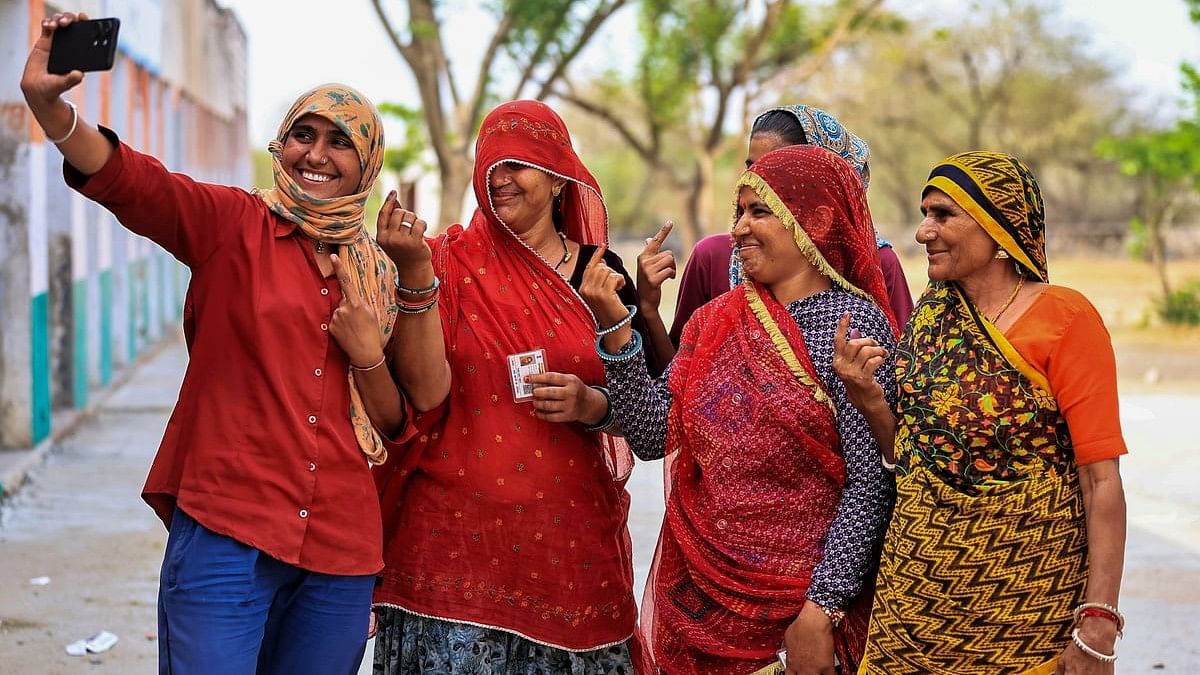
Women voters take a selfie showing their fingers marked with indelible ink after casting votes.
Credit: PTI Photo
Swayamvars and elections — choosing husbands versus leaders in a democracy. Bizarre as it may sound, drawing parallels between these two apparent exercises of choice is the best metaphor to illustrate the options available for Indian voters, especially women. Since India has witnessed the forging of political narratives through the hailing of ancient practices, alluding to swayamvar suits the pop rhetoric.
Women’s participation in making choices is often construed as empowering — underscoring that picking is enough and engagement is not desired. The sexual contract of a swayamvar has parallels with the electoral social contract — both providing a promise of ‘choice’ but delivering an illusion of it at best.
Thanks to the constitutional commitment to universal suffrage, over the years, the gender gap in voter turnout has narrowed. From 46.6 per cent of women’s turnout in 1962 with a gender gap of 16.7 per cent, to women's turnout marginally surpassing men’s in 2024 — a whopping 69.7 per cent were female voters compared to 69.5 per cent of men (till phase six). In 2024, over 310 million women exercised their franchise out of 642 million Indians (65.79 per cent voter turnout).
This growth is reflective of how women, especially young voters, are more independent and empowered in 2024, compared to 1962. A constellation of factors including women’s higher representation in the labour force are responsible for this steady change in the Indian discourse which is now open to women making their ‘choices’. However, the irony is not far behind —often these choices are socially imposed. This is not to say that women are voting blindly following the family patriarch — the workings of patriarchy are much more layered.
Women voters in India are anything but representing a block of interest — intersectional regional, socio-economic, religious, and caste factors influence women’s voting choices. Vox pop commentaries from many women across India are full of praise of Narendra Modi’s strong leadership. An indicator, perhaps, that the ‘choice’ should be taken with a pinch of salt.
In a swayamvar women’s choices are premeditated — women with a specific bracket of men to choose from. These men would fit an endogamous bill belonging to a particular caste, class, and religion — the defining factors in Indian politics. The 2024 Lok Sabha general elections too provided an array of choices for the voters, most strikingly for women — an alleged sexual abuser, the son of a sexual harasser, multiple actors with no true sense of history and the selectively reactive ministers, and even, a leader with larger-than-life divine inclinations.
Restricted electoral choices were of course there. However, for India’s women voters, elections mean, to be wooed, and settle for the bare minimum. Electoral choices are, indeed, gendered narratives — beyond the biological male-female divide.
Like in a swayamvar, the women’s voting behaviour reflects embedded patriarchy. The voting ‘choice’ for women is reflective of an ‘ideal husband’ syndrome, with its foundations laid on three interrelated factors — protection, insecurity, and hypermasculinity. Nonetheless, these factors are not exclusive to the Bharatiya Janata Party (BJP)-led National Democratic Alliance (NDA), and is a part of India’s electoral culture.
The populist welfare schemes base their narratives on giving women social welfare benefits and appeasing them to vote. That reiterates one of the most prevalent values of patriarchy — giving primacy to ‘protection’ over ‘freedom’. The prioritising of populist welfare measures over issues like education and health in India is, thus, deliberate.
The (majoritarian) narratives also play with women’s deep sense of ‘insecurity’ — insecurities which stem from women’s identity. Be it religious or caste identity, for women in India, a sense of security lies in their belongingness and loyalty to the community. So, an electoral reimagining of the mangalsutra stirs the ‘insecurity’. Women being the repository of honour in a community, the breach of mangalsutra is seen as a violation.
Hypermasculinity relates to Indian voters’ affinity towards a ‘strong leader’ — the same reason Indira Gandhi’s strong leadership is often referred to as ‘manly’. It is comparable to women making their ‘choice’ of a husband — an ideal strong man with a temperament capable of heroic protection of women. Indian women voters, then, are looking for a masculine man with his heroic antics — one of which is the quality of being a drastic decision-maker.
This is exactly where Congress leader Rahul Gandhi’s pitch for prime ministerial candidateship falls short — and for all good reasons. From being caricatured as the ‘pappu’ to now being reinstated as a politician to be reckoned with, Gandhi has come a long way in politics. His politics exudes sensitivity.
Beyond an electoral choice, accepting Gandhi’s leadership would also require some gendered unlearning among the Indian voters. As opposed to a hypermasculine pitch of being a ‘strong man’, Gandhi comes across as a gentle personality — caring for animals, connecting with people, walking on the streets during the Bharat Jodo Yatra, respecting democratic institutions, and most importantly, being vulnerable and fallible. All of these redefine what a ‘choice’ for Indian women should look like — be it while choosing a leader or a partner. So, pitching for Gandhi as a prime ministerial face for 2029 would also be a pitch to smash the patriarchy.
(Debangana Chatterjee is Assistant Professor, National Law School of India University, Bengaluru. Twitter: @debangana1992.)
Disclaimer: The views expressed above are the author's own. They do not necessarily reflect the views of DH.